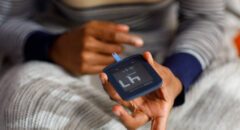 Vinegar continues to gain in popularity among consumers for its many purported health benefits including hypertension, weight loss, dandruff, leg cramps, fungal infections and diabetes. However, there is no clear scientific evidence to support these claims except for diabetes. In fact, there is an emerging body of evidence to support the benefit of vinegar in helping to reduce blood glucose levels.
Vinegar continues to gain in popularity among consumers for its many purported health benefits including hypertension, weight loss, dandruff, leg cramps, fungal infections and diabetes. However, there is no clear scientific evidence to support these claims except for diabetes. In fact, there is an emerging body of evidence to support the benefit of vinegar in helping to reduce blood glucose levels.
A recent review of the body of available control clinical trials that report on the effect of vinegar intake on blood glucose levels after meals was published in the Journal of Diabetes Research and Clinical Practice. Analysis of the studies revealed a significant glucose and insulin reduction in both healthy and participants with diabetes or insulin resistance who consumed vinegar compared with those in the control group who did not have vinegar. The researchers concluded that vinegar could be effective in reducing glucose and insulin levels after meals, indicating it could be considered as a tool to be used with other therapies for improving glucose control.
How Vinegar Lowers Glucose
Acetic acid, the active ingredient in vinegar is believed to lower blood glucose levels in three primary ways: slow digestion; prevent the complete breakdown of starches, and facilitate muscle glucose absorption. There are several types of vinegar available.
The four most common are cider vinegar made from apples, wine vinegar from grapes, malt vinegar from barley and sugar; and white vinegar from distilled diluted alcohol. The amount of acetic acid varies depending on the type of vinegar. Cider and wine vinegar contain 5% to 6% acetic acid, and white vinegar ranges from 4% to 7%.
How Much and What Type of Vinegar
Studies show wine vinegar, white vinegar, and apple cider vinegar all demonstrate the ability to reduce blood glucose levels. However, apple cider vinegar—due to great marketing, is most notable. The reality is all vinegar has acetic acid which is the active ingredient.
The are no official recommendations regarding how much vinegar to use. Carol Johnston, Ph.D., R.D., Professor of Nutrition and Associate Director of the School of Nutrition and Health Promotion at Arizona State University, has been studying the effects of vinegar for more than 10 years. She suggests mixing 1 to 2 tablespoons of vinegar in a big glass of water and sipping it along with meals, one or two times a day.
Vinegar supplements are also available however they are not standardized, and the amount of acetic acid varies. In fact, a 2005 study found that ingredients listed on the supplement box did not reflect the actual ingredients found in the pills.
Side Effects and Interactions
Large amounts of vinegar can irritate the stomach and cause nausea; burn the mouth and esophagus, and damage tooth enamel. Vinegar in large quantities can also decrease potassium levels, which could be life threatening. Vinegar may also worsen gastroparesis (delayed stomach emptying).
If you take laxatives, diuretics, medications for heart disease or diabetes you should check with your doctor before using vinegar or vinegar supplements in significant amounts and or a consistent basis.
Bottom line
If you choose to add vinegar to your daily diabetes regimen, it is important to check your blood glucose more frequently. Checking blood glucose will help prevent unexpected hypoglycemia–low blood sugar. Do not stop taking your diabetes medication. Talk to your health care provider to determine if you require an adjustment in your diabetes medication.
 Constance Brown-Riggs, MSEd, RD, CDE, CDN is a registered dietitian, certified diabetes educator, national speaker and author of The African American Guide to Living Well with Diabetes.. She is Dannon One Yogurt Every Day Nutrition Advisor.
Constance Brown-Riggs, MSEd, RD, CDE, CDN is a registered dietitian, certified diabetes educator, national speaker and author of The African American Guide to Living Well with Diabetes.. She is Dannon One Yogurt Every Day Nutrition Advisor.








